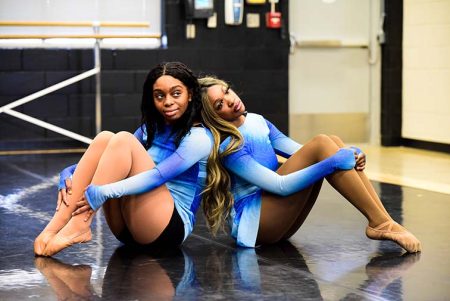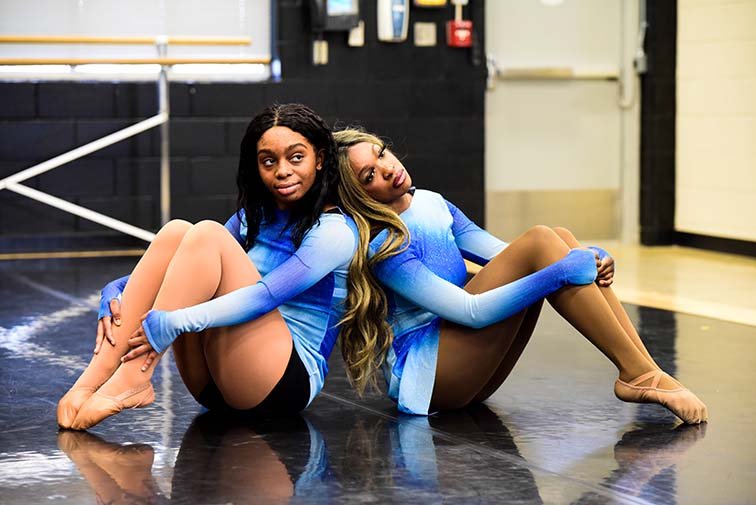
ballet shoes.
Alex Hoben/The Collegian
KEYLA HOLMES
campus editor
keyla.holmes@my.tccd.edu
The ballet world hasn’t always been very supportive of Black artistry. Four Black women discuss their experiences in an industry that culturally and historically hasn’t served them or people that look like them.
Reflecting on her journey so far, SE student Amaya Brooks said what she would tell her younger self- as well as those who may be starting their ballet journey.
“Dear Black girl, don’t try to fit in when you’re born to stand out,” she said. “Growing up you’ve tried to be someone you’re not, even though in reality you’re great as your own. God created you just the way you are, so you don’t have to try and be like anyone else – just do you.”
While expressing one’s self can act as a form of self care, navigating ballet spaces that haven’t always considered the needs of Black dancers can be difficult.
“One of the first things I did while teaching here is every time I’d have a Black student in class I’d ask them, ‘Do you know you can get brown ballet shoes? You don’t have to wear pink ballet shoes because they’re pink to expand the line of the dancer, and they’re based upon white skin,’” instructor Lacreacia Sanders said.
Black dancers have also been expected to meet beauty standards that prevent them from embracing their authentic selves.
“I know in regards to hair, most people have to straighten their hair, or wear their hair a certain way just to fit in with the standard of what it looks like to be a ballerina,” Brooks said. “You can have curly hair, or whatever type of hair texture and still be a ballerina and dance.”
Loving one’s body as a dancer can also be a difficult journey.
“It’s just the idea of trying to still look beautiful and graceful, but like accepting the fact that this is my body and how I move,” SE student Makel Dandridge said. “I can still be an amazing dancer and not fit the stereotype of a ballerina.”
Growing up in the ballet world, Dandridge said that identifying with being Black didn’t always feel easy or empowering.
“There was a little bit of self hate,” she said. “I didn’t really identify with my blackness at the time because I just remember so much negative chit chat amongst the people I was around.”
Dandridge said that feeling confident in her identity was a part of the struggle she experienced in predominantly white ballet studios.
“I did ballet for 10 years when I was a kid and I just remember being in a lot of spaces where my Blackness was being questioned,” she said.
Representation can be important and allow people to feel like there’s space cultivated for them to accomplish their dreams.
“It wasn’t until I got a little older and found people like Martha Graham and Misty Copeland – like there are Black people who are capable at doing ballet and who are exquisite at it,” she said.
According to Sanders, the dance world is slowly but surely changing. She said there’s more opportunity for artists now than when she was growing up in the 80’s.
Making sure her students are aware of the role they play in that change, she said, is important.
“Dear Black student, you are Black history,” Sanders said. “I didn’t realize that until I got older. You are in a time when dance is changing. A time where dance wants to make a space for you.
With more Black bodies in a plie position, a common ballet term in which the dancer bends their knees, the more aspiring dancers, such as NW student Jaide Chavez, feel amazed at how much progress the Black community has made in the industry.
“At a time, black people weren’t allowed to do ballet, so seeing how far we’ve come and seeing how many of us are in ballet and doing dance of all styles, is really amazing.”
Even with the progress supposedly being made in ballet spaces, Sanders said there’s still issues to address.
“You could have a whole other article on ballet and the LGBTQ+ community, especially in regards to Black people.”
Dandridge said that the pressure to get things right as a Black woman can be overwhelming.
“There’s a lot of pressure as a Black woman because it feels like you can’t be the only Black person in that space and not be getting it right,” she said.
Among the different struggles Black people face in the industry, Dandridge said that Black boys and men can struggle with adversity and don’t always gain the necessary support. She said what she would like them to know.
“Dear Black boy, nothing in this life is given to you. That is true, but that’s why you were blessed with the gift of resilience. This is my motto – prayer, supplication and problem solving. Those are the ways to get through adversity in life. Believe in yourself.”

